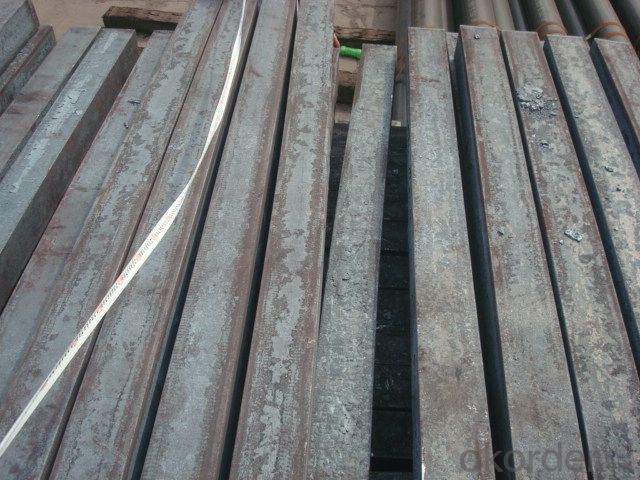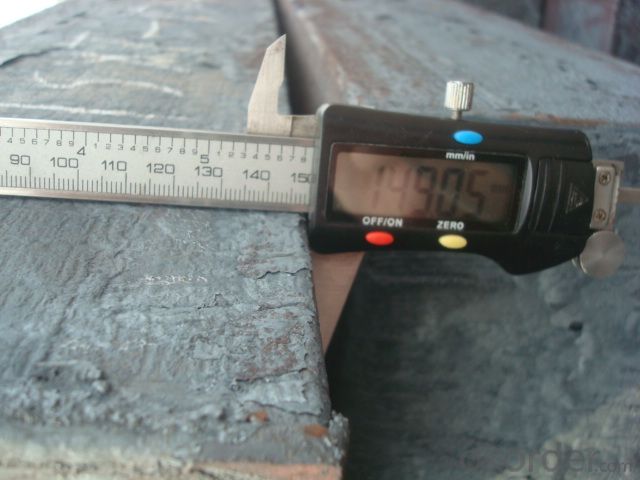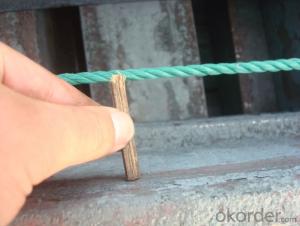Steel Billet Hot Rolled in Amazing Price
- Loading Port:
- Tianjin
- Payment Terms:
- TT OR LC
- Min Order Qty:
- 1000 m.t.
- Supply Capability:
- 50000 m.t./month
OKorder Service Pledge
OKorder Financial Service
You Might Also Like
1.Structure of Steel Billet
Steel billet(ingot) by cogging or breakdown of semi-finished products, is the raw material of all kinds of steel mill. Billet section of square, round, flat, rectangular and abnormity of several kinds of, mainly related to the shape of rolled products.
2.Main Features of Steel Billet
Rectangular billet continuous casting billet and mainly general carbon steel, low carbon low silicon cold-rolled material, high quality carbon structural steel, high strength low alloy steel, special steel, etc.
The billet is mainly divided into two kinds from the shape:
Slab: cross section width and height of the ratio of the larger, mainly used for rolling plate.
Billet: equal cross section width and height, or a huge difference, mainly used for rolling steel, wire rod. ,
Steel billets have distinct characteristics as compared with already furnished steel bars and products. Billets have a specific grain structure, which enables the metal to be processed more intricately. Steel billets are also known for their malleability and ductility, especially when exposed to varying temperatures during shaping and molding.
3.Steel Billet Images


4. Steel Billet Specification
Hot rolled billet steel
Size: 50x50mm-180x180mm
Steel Grade: 3SP, 5SP,Q195,Q235,Q255,Q275 Length:3m-12m
MOQ: 1000MT/size
Payment term: TT or LC
Packing: in bulk , bundle
Shipment: by container , bulk vessel
Packaging Details: bundles with steel strips or as customers's requirements
Delivery time: 15-30 days after the deposit
Loading port:Tianjin, or other port China
Origin :China
Inspection:Third party inspection before loading.
5.FAQ
We have organized several common questions for our clients,may help you sincerely:
1) How about your company?
A world class manufacturer & supplier of castings forging in carbon steel and alloy steel,is one of the large-scale professional investment casting production bases in China,consisting of both casting foundry forging and machining factory. Annually more than 8000 tons Precision casting and forging parts are exported to markets in Europe,America and Japan. OEM casting and forging service available according to customer’s requirements.
2) How long can we receive the product after purchase?
In the purchase of product within three working days, We will arrange the factory delivery as soon as possible. The pecific time of receiving is related to the state and position of customers.Commonly 7 to 10 working days can be served.
3) Can you guarantee the quality of mass production?
Yes, of course. We will send pre-production samples to you for confirmation, after your confirmation we will start mass production. The quality of mass production will be the same as the samples you confirmed to us.
- Q:What are the main factors affecting the impact toughness of steel billets?
- The main factors affecting the impact toughness of steel billets include the composition of the steel, the heat treatment process, the presence of impurities or defects, the grain size and microstructure, and the temperature at which the impact test is conducted.
- Q:What are the common shapes of steel billets?
- Depending on their intended use and manufacturing process, steel billets can be found in a range of shapes. Square, rectangular, round, and hexagonal are among the most common shapes. Square billets are typically utilized in applications that require stability and strength, such as construction materials and machinery parts. For structural components in construction and engineering projects, rectangular billets, with their elongated shape, are commonly employed. Round billets are often chosen for the production of pipes, tubes, and other cylindrical objects. As for hexagonal billets, their six-sided shape is frequently used in the manufacturing of hex nuts, bolts, and other fasteners. These various shapes offer versatility in order to meet the diverse requirements and applications of different industries.
- Q:What are the main alloying elements used in steel billet production?
- Steel billet production utilizes various alloying elements, such as carbon, manganese, silicon, and chromium. The primary alloying element, carbon, plays a crucial role in augmenting the steel's strength and hardness. Meanwhile, manganese is incorporated to enhance the steel's toughness and hardenability. Silicon is introduced to fortify the steel against corrosion and oxidation. Lastly, chromium is employed to heighten the steel's hardness, corrosion resistance, and wear resistance. Throughout the production process, these alloying elements are meticulously regulated and added to the steel to attain the desired properties and attributes in the ultimate steel billets.
- Q:What is the role of steel billets in the manufacturing of structural steel bridges?
- Steel billets play a crucial role in the manufacturing of structural steel bridges as they serve as the primary raw material for the production of steel beams and other structural components. These billets are heated and then shaped into desired forms through processes like rolling or forging. Their high strength and durability make them ideal for constructing the load-bearing elements of bridges, ensuring the structural integrity and longevity of the final bridge product.
- Q:How are steel billets used in the manufacturing of power plant equipment?
- Steel billets are used in the manufacturing of power plant equipment as they serve as the raw material for various components such as turbine blades, shafts, and boiler tubes. These billets are shaped and machined to form the specific parts needed for power generation, ensuring strength, durability, and high-performance capabilities in the harsh operating conditions of power plants.
- Q:What are the main factors affecting the machinability of stainless steel billets?
- The machinability of stainless steel billets is influenced by several key factors. 1. Alloy composition: The composition of stainless steel, including the presence of various alloying elements, significantly affects its machinability. Certain elements such as sulfur, lead, and selenium can improve machinability by enhancing chip formation and reducing tool wear. On the other hand, elements like chromium and nickel, which are commonly found in stainless steel, can increase hardness and reduce machinability. 2. Hardness: The hardness of stainless steel billets plays a crucial role in determining machinability. Higher hardness levels make the material more difficult to cut, which can result in increased tool wear and reduced efficiency. Hardness can be influenced by various factors, including alloy composition, heat treatment, and mechanical processing. 3. Heat treatment: The heat treatment process employed on stainless steel billets can greatly impact their machinability. Heat treatment can alter the microstructure of the material, affecting its hardness, toughness, and ability to be machined. For example, annealing can soften the stainless steel, making it more machinable, while processes like hardening or tempering can increase hardness and reduce machinability. 4. Cutting tool selection: The choice of cutting tools used for machining stainless steel billets is crucial in achieving optimal machinability. Stainless steel is known for its tendency to work-harden, which can lead to increased cutting forces and tool wear. High-speed steel (HSS) and carbide tools are commonly used for machining stainless steel due to their superior hardness and wear resistance. 5. Cutting parameters: The selection of appropriate cutting parameters, such as cutting speed, feed rate, and depth of cut, is essential for achieving good machinability in stainless steel billets. The cutting parameters must be carefully chosen to balance the desired metal removal rate with minimizing tool wear and heat generation. Adjusting these parameters can help optimize chip formation, tool life, and surface finish. 6. Lubrication and cooling: The use of proper lubrication and cooling techniques during machining can significantly influence the machinability of stainless steel billets. Lubricants help reduce friction and heat generation, improving chip formation and extending tool life. Cooling methods, such as flood or through-tool cooling, can dissipate heat and prevent thermal damage to the workpiece and cutting tool. All these factors interact with each other to determine the machinability of stainless steel billets. A thorough understanding of these factors allows manufacturers to optimize the machining process and achieve efficient and cost-effective production of stainless steel components.
- Q:How are steel billets used in the manufacturing of industrial valves?
- Industrial valves rely heavily on steel billets as a vital element in their production. These valves are critical devices utilized to regulate the movement of fluids and gases in a wide range of industrial operations. Steel billets, which are partially processed metal products, play a crucial role in the creation of these valves. The manufacturing process for industrial valves typically involves multiple stages, including forging, machining, and assembly. Steel billets are primarily employed during the forging phase of valve production. Forging is the technique of shaping metal by applying localized compressive forces using dies or hammers. Steel billets are heated to a specific temperature and then subjected to intense pressure, causing them to take on the desired shape. The use of steel billets in the forging of valves presents several advantages. Firstly, steel is renowned for its exceptional strength and durability, making it an ideal material for valves operating under high-pressure conditions. Steel billets supply the necessary raw material to create sturdy and dependable valve components. Furthermore, steel billets can be easily molded and shaped during the forging process. This allows manufacturers to craft intricate valve designs with precision and accuracy. The versatility of steel billets facilitates the production of valves in various sizes, shapes, and configurations to meet specific industrial requirements. Moreover, steel billets can undergo heat treatment after forging to enhance their mechanical properties. Heat treatment methods such as quenching and tempering can greatly improve the hardness, strength, and wear resistance of valve components. This ensures that the valves can withstand demanding operating conditions and deliver optimal performance over an extended period. In conclusion, the utilization of steel billets is indispensable in the manufacturing of industrial valves. These billets provide the raw material necessary for forging robust valve components, offering strength, durability, and versatility. Leveraging steel billets enables the production of high-quality valves capable of efficiently controlling the flow of fluids and gases in industrial processes.
- Q:What are the different finishing processes used for steel billets?
- There are several different finishing processes used for steel billets to achieve the desired surface quality and dimensions. These processes include: 1. Hot rolling: This process involves passing the steel billets through a series of heated rollers to reduce their thickness and shape them into the desired profile. It can be used to produce a variety of finished products, such as bars, rods, and structural shapes. 2. Cold drawing: In this process, the steel billets are pulled through a series of dies at room temperature to reduce their cross-sectional area and improve their surface finish. Cold drawing is commonly used to produce high-quality steel bars and wires with precise dimensions and a smooth surface. 3. Peeling: Peeling is a machining process in which a thin layer of material is removed from the surface of the steel billets using a cutting tool. This process helps to improve the surface finish, remove any defects, and achieve tight dimensional tolerances. 4. Grinding: Grinding involves using an abrasive wheel or belt to remove material from the surface of the steel billets. It is commonly used to remove surface defects, such as scale and rust, and to achieve a smooth and uniform surface finish. 5. Polishing: Polishing is a finishing process that involves using abrasive materials, such as polishing compounds and buffing wheels, to create a smooth and reflective surface on the steel billets. It is often used to enhance the aesthetic appeal of the finished product and improve its resistance to corrosion. 6. Coating: Coating is a process in which a protective layer is applied to the surface of the steel billets to improve their resistance to corrosion and other environmental factors. Common coating methods include galvanizing, where a layer of zinc is applied to the surface, and painting, where a layer of paint or other protective material is applied. Overall, these finishing processes are essential in ensuring that steel billets meet the required specifications and standards for their intended applications. They help to improve the surface finish, dimensional accuracy, and overall quality of the finished steel products.
- Q:What are the main advantages of using steel billets in manufacturing?
- The main advantages of using steel billets in manufacturing include their high strength and durability, versatility in shaping and molding, excellent heat and corrosion resistance, and cost-effectiveness. Steel billets provide a reliable and consistent material for various applications, ensuring structural integrity and longevity in the manufactured products. Additionally, their malleability allows for easy customization and adaptation to different manufacturing processes, making steel billets a preferred choice for many industries.
- Q:How do steel billets contribute to the shipbuilding industry?
- Steel billets are a crucial component in the shipbuilding industry as they play a significant role in the construction of ships. These semi-finished products are essentially molten steel that has been solidified into a specific shape, usually a square or rectangular block. They are typically obtained through the process of continuous casting or ingot casting. One of the primary ways in which steel billets contribute to the shipbuilding industry is by providing the raw material for the fabrication of various ship components. These billets are further processed through rolling, forging, or extrusion to create different structural elements, such as plates, beams, angles, and channels. These components are then used in the construction of the hull, decks, bulkheads, and other structural parts of the ship. Steel billets also possess several advantageous properties that make them ideal for shipbuilding. Their high strength and durability ensure the structural integrity and longevity of the ship, enabling it to withstand the harsh marine environment and constant exposure to seawater. Moreover, steel billets have excellent weldability, which allows for efficient and reliable joining of various components during the ship assembly process. Furthermore, the use of steel billets in shipbuilding offers a cost-effective solution. Steel is readily available and abundant, making it a cost-efficient material choice for the construction of ships. Additionally, steel is highly recyclable, allowing for the reuse of steel billets and reducing environmental impact. In summary, steel billets are vital to the shipbuilding industry as they provide the raw material for the fabrication of various ship components. Their high strength, durability, weldability, and cost-effectiveness make them an ideal choice for constructing ships that can withstand the demanding marine environment. Ultimately, steel billets contribute to the safe and reliable operation of ships, supporting the growth and development of the shipbuilding industry.
1. Manufacturer Overview |
|
|---|---|
| Location | |
| Year Established | |
| Annual Output Value | |
| Main Markets | |
| Company Certifications | |
2. Manufacturer Certificates |
|
|---|---|
| a) Certification Name | |
| Range | |
| Reference | |
| Validity Period | |
3. Manufacturer Capability |
|
|---|---|
| a)Trade Capacity | |
| Nearest Port | |
| Export Percentage | |
| No.of Employees in Trade Department | |
| Language Spoken: | |
| b)Factory Information | |
| Factory Size: | |
| No. of Production Lines | |
| Contract Manufacturing | |
| Product Price Range | |
Send your message to us
Steel Billet Hot Rolled in Amazing Price
- Loading Port:
- Tianjin
- Payment Terms:
- TT OR LC
- Min Order Qty:
- 1000 m.t.
- Supply Capability:
- 50000 m.t./month
OKorder Service Pledge
OKorder Financial Service
Similar products
New products
Hot products
Hot Searches
Related keywords






























